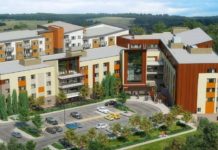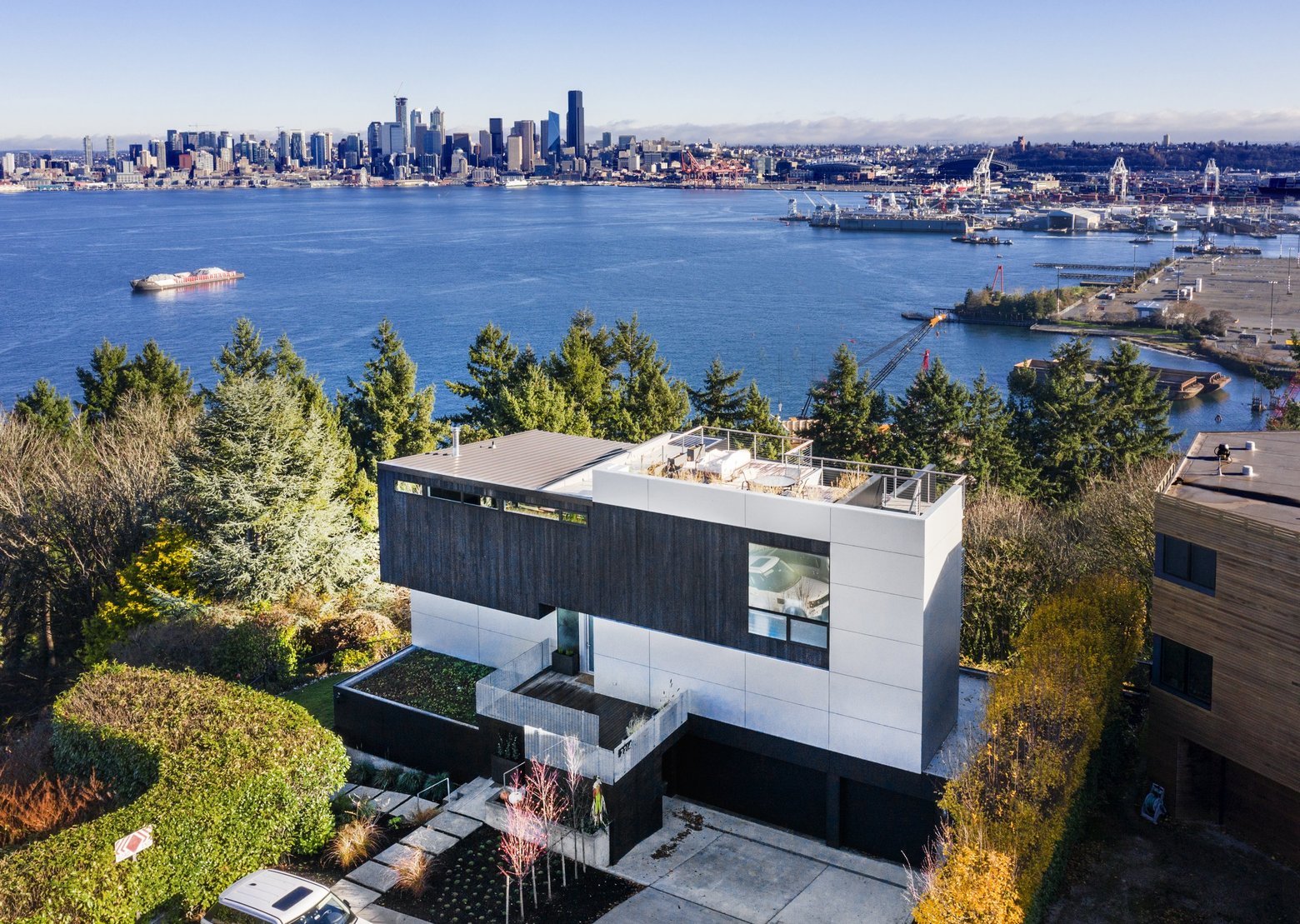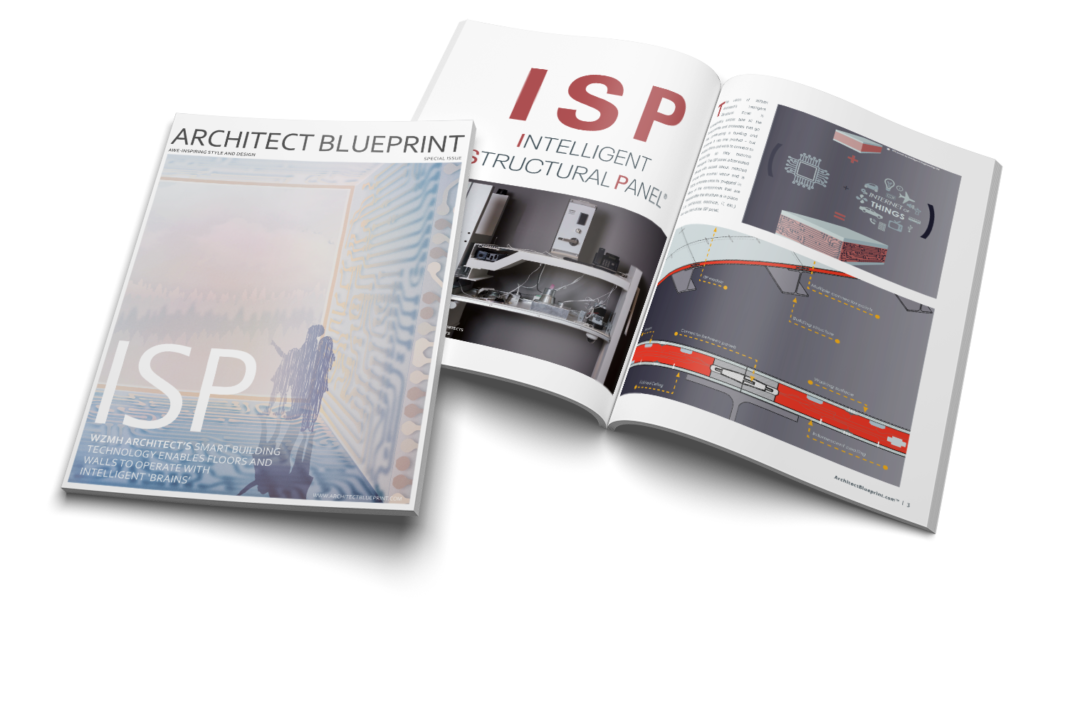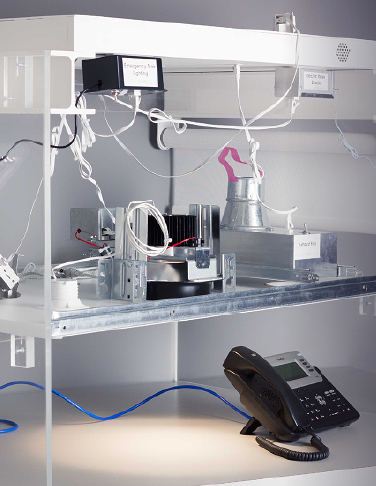Download this Issue of Architect Blueprint Magazine.
ISP: Intelligent Structural Panel®
WRITTEN BY: WZMH Architects Team
COVER GRAPHIC BY: Ruta Krau, WZMH Architects
OTHER IMAGES + GRAPHICS BY: WZMH Architects
The vision of WZMH Architect’s Intelligent Structural Panel is conceptually simple: take all the components and processes that go into constructing a building and combine it into one product – but enable floors and walls to connect to technology so they become intelligent.
The ISP panel is fabricated off-site with skilled labour, installed on-site with minimal labour and is 100% complete once its ‘plugged’ in. Many of the components that are installed after the structure is in place (i.e. mechanical, electrical, IT, etc.) are now part of the ISP panel.

Creating a More Intelligent Building System
WZMH Architect’s Intelligent Structural Panel (ISP) is a concept idea that combines two very different components – a sandwich plate system and the ‘Internet of Things’. These two components result in an intelligent building system that can be used for floors and walls in lieu of traditional structural elements such as reinforced concrete or steel decking – but with the added benefit of containing the building’s intelligent infrastructure.

WZMH Architect’s is taking the lead on a 12-person ISP project team (which consists of additional members from the engineering firms Quasar Consulting Group, Stephenson Engineering, and start-up C3PoE), working in collaboration with Microsoft’s AI & IoT Insider Labs to develop the ISP panels.
The Intelligent Structural Panel (ISP) includes a sandwich plate system pioneered by Intelligent Engineering, known as SPS® (www.ie-sps.com) which includes a top steel plate, polyurethane core (developed jointly by BASF) and a bottom steel plate. The thickness of the SPS® panel varies depending on project requirements but generally a 50mm thick panel is equivalent to a 200mm thick reinforced concrete slab.
The ISP solution incorporates a number of various electronic components within the core of the SPS panel – resulting in a structural panel that in essence acts as a computer motherboard – with sensors, speakers, electrical and data distribution, heat and smoke detection, radiant floor heating, etc. The ISP incorporates a large number of what are typically surface mounted and exposed services – all contained within the core of the panel.
The key feature of the ISP is the intelligent infrastructure that communicates with the Internet of Things and provides a solution for the occupants in the building that is geared towards a user friendly, barrier-free, accessible and safe environment. The future of the ISP will be a panel system that will be capable of an infinite number of solutions for all users of buildings.

The Concept
The Intelligent Structural Panel is a prefabricated and modular structural solution for floors and walls for all building types.
The ISP’s structural component is the sandwich panel that consists of top and bottom steel plates (or other metals such as aluminum) that are bonded to a core such as polyurethane. The composite action of the sandwich plate system (SPS) provides for a structural solution that is much lighter and thinner in depth versus traditional solutions (steel decking with concrete or reinforced concrete). The SPS system can also be used for structural shear walls around elevator and stair shafts and other locations – this combined with the ‘intelligent’ core will result in a truly smart building from top to bottom.
The core of the sandwich plate system is the polyurethane which bonds the two steel plates of the SPS panel and the element which binds all electronic and other components of the panel – resembling that of a computer motherboard or microchip.
The components within the core of the panel, when connected with the building’s infrastructure, results in horizontal and vertical surfaces that in essence become ‘live’ and interactive with the occupants – resulting in a built environment that is designed to make our lives safer, efficient, user friendly, mobile, barrier-free, flexible and enjoyable.
How It Works
The Intelligent Structural Panel works by incorporating ‘smart’ components within the core of horizontal and vertical surfaces within buildings. Occupants that work or circulate within spaces that include the ISP panels interact with intelligent infrastructure through sensors that area triggered by touch (hand and foot movement), sound (voice commands), and other interactive devices such as canes, mobile devices, etc.
The ISP panels are modular (can be constructed of any size up to the limitations imposed by shipping and installation on site) and are designed to be connected to each other through the edges of the panels. Solutions include: traditional male and female connectors, universal plug-in points and connectivity between panels by simply touching the ends together (by means of two continuous copper strips).
The ISP panels connect at the floor (which includes the ceiling) and wall surfaces with the various connector options and to a common (or multiple) Point of Presence (POP) on the floor or within the building. This POP room (which can also be constructed of ISP panels) will be the main gathering hub for all communicating entities (demarcation point) that service the ISP and the exit path to connect to other buildings and infrastructure (road networks, etc.) The ISP panel includes technology that incorporates both wireless and wired communication including Wi-Fi and Li-Fi (visible light communication).
The ISP also includes technology that replaces traditional building components such as life safety and heating components. The ISP panel includes a VESDA (very early smoke detection apparatus) system via pin hole locations scattered throughout the bottom (or top or both sides) of the panel.
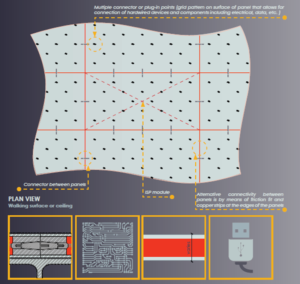
Radiant heating is accomplished by harnessing the heat generated by the internal electronic components and releasing this warm energy at selected locations – including infrared radiation from the ceiling. The ISP panels, being modular, allow for easy removal and replacement to address deficiencies or technological improvements. As technology improves over time, it is envisioned that only certain ISP panels will need to be replaced (for example, one or two within an office floor plate) and the remaining panels can remain in situ.
Basic Components
The Intelligent Structural Panel (ISP) is made up of three key components: steel or metal plates, binding core (polyurethane) and the electronic technology. The steel or metal plates and the polyurethane core is the sandwich plate system by Intelligent Engineering, known as SPS (www.ie-sps.com). The steel or metal plates and core can be provided in various thicknesses – all dependent on the use and structural loads that the panel must accommodate. Detailed information on the steel plates and the core is available through Intelligent Engineering.
The electronic technology or computer motherboard within the core of the ISP makes the panel system ‘intelligent’ and is designed to connect to multiple modules – both horizontal and vertical. Connectivity between panels is via plug-in type connectors that bundle all wiring (including fibre optics) in multiple locations along the perimeter edge of the panel to allow for precision coupling to adjacent ISP panels.
Sub-components or parts of the ISP panel include items necessary to ensure the spaces that are formed by the panel are safe and comfortable environments. These subcomponents include: intumescent coating (paint) applied to the steel plates to provide a fire resistance rating (if required); floor underlayment for acoustical purposes and; light emitting diodes, attached to the panel for emergency and general lighting purposes.
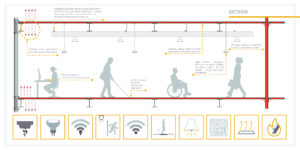
Benefits of the ISP
The Intelligent Structural Panel (ISP) incorporates both technology and structure into one component, resulting in a building where the ‘skeleton’ or frame is ‘smart’ and provides the occupants with an environment that has access to the Internet of Things.
By incorporating technology into the structure and modularizing the panels (ISP panels manufactured off-site), the process of constructing a building is more efficient and completed in a shorter timeframe versus traditional solutions. A building constructed of ISP panels will required less workers on site versus traditional builds as a result of combining the majority of electrical and data distribution within the modular panel.

Use of the ISP panel as a floor assembly in office environments allows for complete flexibility in the design and configuration of open workstations and fixed offices. The panels include a multitude of ports to connect both power and data and it is envisioned that the future generations of the ISP will allow for just one connection on any location on the panel for both power and data.
One of the key benefits of the Intelligent Structural Panel is in floor sensors that can interact with a large number of devices including: canes for the visually impaired to direct them throughout buildings, subway stations, airports, etc.
For those that are hearing impaired, interaction between in floor sensors and hand held devices will identify people or moving objects at busy corridor intersections. Minuscule vibrations in the floor at their sitting or standing location will notify both visually and hearing impaired persons of an emergency and where to evacuate safely.
The benefits of the ISP is really limitless when the concept goes well beyond the building structure and starts to incorporate certain things people use on a day to day basis: floors for buses, railway cars, streetcars and subways, crosswalks at key intersections, furniture, etc. When the ISP concept is integrated into the infrastructure to travel and be present at the places we live, work and play, the environment created will be one that will truly be safer and accessible to all.
ISP Raised Access Flooring

The Intelligent Structural Panel (ISP) replaces traditional concrete steel pan raised access floor tiles with an ‘all in one’ flooring solution for office and mission critical environments. All power, IT and security cabling is integrated into the panel resulting in a ‘wire free’ space. With the added benefit of in floor sensors, the ISP raised access floor tiles monitor air movement and temperature – either above or below the floor and provide smoke detection (VESDA).
The panels interconnect at the edges with copper strips that are in compression when tightly fitted against another panel. When panels need to be removed (for access below the floor), power/IT/security within the ISP is re-routed remotely from a computer – zero disruption to operations. IT equipment (racks and servers) plug directly into the ISP panel or are connected via a wireless solution.
The ISP raised access floor panel can be seen as the potential first step in transformation of a complete building structure to an intelligent solution or this solution can be used in existing buildings to retrofit the floor (not the ceiling) to provide many features and components of the ISP.
What’s Your Architectural Dream?
Convert your thoughts and dreams into reality by taking that first step.
WZMH Architects
95 St. Clair Ave. West, Suite1500
Toronto, Ontario, Canada M4V 1N6
p: 416.961.4111
info@wzmh.com
www.wzmh.com














